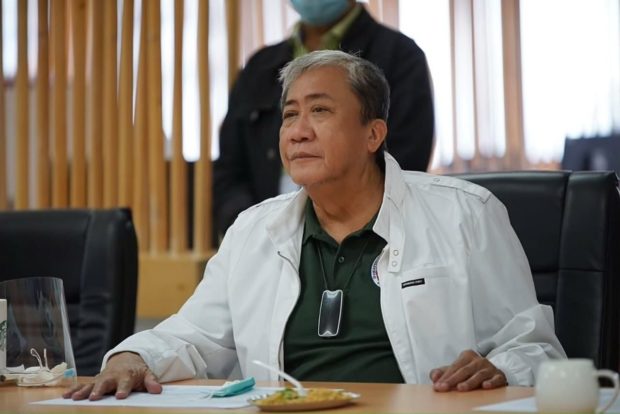DOTr to defend proposal to increase passenger capacity in public transport

Transportation Secretary Arthur Tugade. FILE PHOTO
MANILA, Philippines – The Department of Transportation (DOTr) is ready to defend on October 28, its recommendation to increase passenger capacity in public transportation, road, and rail, with pilot implementation in Metro Manila, before the Inter-Agency Task Force for the Management of Emerging Infectious Diseases (IATF-EID).
During the public hearing of the subcommittee of the Senate Committee on Finance on the Proposed 2022 Budget of the DOTr and its attached agencies on October 26, 2021, Assistant Secretary for Road Transport and Infrastructure Steve Pastor said the DOTr has submitted to the IATF its formal position paper on the increase in passenger capacity for public transport.
The recommendation to increase passenger capacity in public transport is one of the measures being considered by the DOTr to help drivers and operators amid the pandemic and the continued increase of fuel prices. Pilot implementation will be in Metro Manila.
“Nakapag-submit na po ang road sector ng formal position paper na i-increase ang seating capacity from 50% na para po sa amin, kung masusunod ang kagawaran, ay pwedeng maging 100% based on medical literature that is available. At the same time, we are ready to defend our position to IATF this Thursday. Alam naman natin na mayroon pa rin tayong dapat idulog sa IATF dahil this is not only a matter of public transportation but also a matter of public health,” Pastor said.
The DOTr’s proposed passenger capacity increase in public transport, with a pilot run in Metro Manila, is anchored on the following arguments:
1. Metro Manila is now under Alert Level 3, which allows for more businesses to open, and more people going out, which resulted to greater demand for public transport. Studies have shown that reliance on complete face mask use and partial hand sanitizer use were proven enough to contain three very modest COVID-19 waves while preserving normal bus services. Other studies have also revealed that passengers in the high-risk zones (seats in the same row with an infected passenger and within 3 rows) had moderate but not significantly higher risk, and that “rigid” safe distancing rules are an oversimplification based on outdated science and experiences of past viruses.
2. The livelihood of public transport drivers and operators were severely affected with passenger capacity in public transport maintained at 50%. Increasing passenger capacity will mean a higher revenue for the public transport sector. This will be a welcome development considering the increase in expenses brought by increasing fuel prices.
3. Metro Manila is the ideal place to test the proposal considering that 81.4% of its population is now fully vaccinated against COVID-19. In addition, public utility jeepneys and buses operating in Metro Manila are well-ventilated.
4. The DOTr had also conducted a rapid analysis of available data on COVID-19 cases (7-day average cases per 1 million population) and public transport capacity, which covered 10 countries (Philippine, Indonesia, Thailand, Japan, Taiwan, Singapore, China, Australia, Vietnam, and Malaysia). It was found out that public transport capacity has no significant correlation with the number of COVID-19 cases
5. Evidence also suggest that high vaccination rate prompts an increase in allowed PUV capacity.
Provision of Fuel Subsidy, Service Contracting instead of Fare Hike
In line with the position of DOTr, led by Tugade, that the department is against any fare increase as well as to balance the need of drivers and operators and the commuting public, Asec. Pastor also emphasized that hikes in fuel prices should not be shouldered by the passengers.
“Ayaw po namin sa Kagawaran na tumaas ang pamasahe dahil para po sa amin walang kinalaman ang commuting public sa pagtaas ng presyo ng krudo kaya ayaw namin na sila ang pumasan dito,” Asec. Pastor said.
Earlier this month, the DOTr requested the Department of Energy (DOE) to grant fuel subsidy to public transport drivers. The Department likewise welcomes the announcement of the Development Budget Coordination Committee (DBCC) for the release of P1.0 billion to the Land Transportation Franchising and Regulatory Board (LTFRB) as fuel subsidies.
Meanwhile, the DOTr previously implemented the Service Contracting Program where drivers and operators of public utility vehicles (PUVs) are paid on a per kilometer run basis. As of the latest data, the (LTFRB) has P4.7 billion of payouts and incentives to PUV drivers and operators for the Service Contracting under Republic Act 11494 or Bayanihan to Recover as One Act and the General Appropriations Act (GAA).
“Noong June 30, 2021, umabot sa P1,907,192,708, ang naipamahagi natin sa mga tsuper at operator under Service Contracting. P2,289,506,007 naman ang naibahagi natin mula September 13 hanggang October 23 mula sa Bayanihan 2, habang P539,672,859 naman mula September 13 hanggang October 23 sa ilalim ng GAA,” LTFRB Chairman Martin Delgra III said.
In line with Service Contracting, a 53,226,651 total ridership was already recorded for the “Libreng Sakay” Program for medical frontliners, APOR, and essential workers.
RELATED STORIES:
DOTr to recommend increase in PUV passenger capacity in NCR
DOTr wants PUVs passenger capacity restored to 100% in Metro Manila